Mark Sisson's Blog, page 52
March 15, 2021
How to Use Egg Yolks as an Alternative Thickener
 Every chef has a few tricks up their sleeve. Whether it be unexpected ingredient combinations to curious kitchen gadgets, these tiny hacks can make or break your at-home recipes. If you follow a dairy-free or gluten-free diet, creating the perfect consistency without a butter-flour roux in recipes can be challenging to even the most studied cooks. One method to keep in your back pocket is using egg yolks to thicken sauces and soups, and to turn leftover pan liquid into a dreamy flavor infusion.
Every chef has a few tricks up their sleeve. Whether it be unexpected ingredient combinations to curious kitchen gadgets, these tiny hacks can make or break your at-home recipes. If you follow a dairy-free or gluten-free diet, creating the perfect consistency without a butter-flour roux in recipes can be challenging to even the most studied cooks. One method to keep in your back pocket is using egg yolks to thicken sauces and soups, and to turn leftover pan liquid into a dreamy flavor infusion.
Once you get the hang of it, using egg yolks as a thickening agent is a relatively simple way to create a deep, rich flavor and texture, plus a little punch of protein. This process requires some finesse: undercooking just makes things messy, and overcooking could lead to an unwanted version of scrambled eggs.
That said, there’s no need to be intimidated. Eggs are cheap enough to experiment with until you get into the swing.
Tempering Eggs to Thicken SaucesTo thicken sauces and prevent an unwanted scramble, it’s crucial that you temper the yolk mixture. Simply put, tempering means you bring the egg yolks slowly up to the temperature of the liquid you’re mixing it with. If the temperature increases too quickly, the proteins in the yolks link up to make scrambled eggs. Here’s how to do it:
Crack and beat your yolks in a bowl.Slowly and gradually add about a cup or so of the heated sauce, soup, or liquid, while whisking. Add a little more to make sure it is warming.Add this mixture slowly back into your pot or pan to finish thickening the sauce, stirring while you pour. Tip: If the sauce is at a boil, it’ll curdle, so be sure to lower the heat.If a recipe calls for a roux (flour and egg), you can use the yolk alone: temper egg yolks into a hot dish and whisk briskly.
Fun fact: Primal Kitchen® just updated the Ranch Dressing recipe, adding organic egg yolks, a natural emulsifier, for a thicker, creamier dressing that’s still dairy-free.
Elevate Your Greens Game with Egg Yolks
If you’re cooking greens that produce an excess liquid in the bottom of the pan, you can make an effortless sauce that goes with any green. Here’s how to do it:
Cook your greensRemove your pan from heatRemove greens from your pan, leaving as much liquid in the bottom of your pan as you can.Add an egg yolk to the remaining liquid in the pan and stir briskly.Using Egg Yolks for a Dreamy Pasta SauceTo add yolks to gluten-free pasta dishes, scoop out and set aside about a cup or so of pasta water before draining. Make a well in the center of the pot with the pasta, and add in a bit of the water and yolk, and stir, coating the pasta with the mixture as you go. The trick is to keep it moving.
Once your yolk is cooked through, it will act as a glaze to whatever else is in the pan, so use yolks for pasta, meat, veggies, or greens.
Final Tips for Using Eggs as a ThickenerImportant: If you’re cooking in an aluminum pan, don’t use egg yolks to thicken–they’ll turn gray.As with any recipe, the quality of your ingredients affects the quality of your outcome. Here’s how to buy high-quality eggs.Eggs are a little finicky, and it might take a few tries to get the hang of it. But once you do, you’ll open up a whole new world of creamy, saucy deliciousness.Egg yolks work as a thickener for a lot of applications, but they don’t work for everything. If you want more ideas for ways to thicken sauces, gravies, and soups, check out this article on how to thicken sauce without flour. (function($) { $("#df7a23U").load("https://www.marksdailyapple.com/wp-ad..." ); })( jQuery ); 
The post How to Use Egg Yolks as an Alternative Thickener appeared first on Mark's Daily Apple.



March 13, 2021
4 Budget Carniflex Recipes: Cost-effective Ground Beef Bowls for the Carnivore Diet
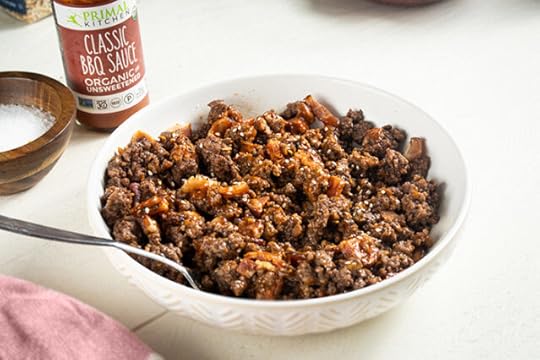 Soon after starting a carnivore diet, you may be wondering what to eat to keep things interesting. With an eating style that’s so restrictive, it’s easy to get bored quickly.
Soon after starting a carnivore diet, you may be wondering what to eat to keep things interesting. With an eating style that’s so restrictive, it’s easy to get bored quickly.
That’s where sauces, dressings, and marinades come in. If you’re pure carnivore, those are out, but a lot of people are adopting a Carniflex style of eating so that they can add flavor and variety to their meals. It’s been the Primal philosophy all along that you’ll stick with a healthy habit if 1. it doesn’t feel too restrictive, and 2. you can keep things exciting!
Primal Health Coach Brian has been eating a Carniflex style diet for some time now, and he’s here to share his tips and tricks to avoid getting stuck in a rut.
One of his favorite hacks is to use ground beef for the convenience and versatility it offers. He came up with four different Carniflex ground beef bowls that he makes in just minutes for a quick breakfast, lunch, or dinner.
Why Use Ground Beef on a Carnivore or Carniflex Diet?Ground beef has a lot of appeal to carnivore dieters for its:
Ease of preparation. Ground beef cooks in minutes, and it’s as simple as browning it in a pan. No fancy techniques required.Versatility. You can experiment with mixing a lot of things like organ meats, sauces, marinades, collagen, herbs… the possibilities are endless.Cost effectiveness. Carnivore can be expensive, if you’re reaching for a ribeye or three every day. But ground beef is cheaper and just as satisfying.Carnivore Diet Cost: Steak vs. Ground BeefGround beef is a lot less expensive than steak. If you watch for sales, you can easily find grass-fed ground beef, fresh or frozen, for around $5 a pound. You might find bulk or conventional ground beef cheaper, and you might find it more expensive, too. At the time this article was published, you can expect to pay around $5 a pound.
A lot of carnivore diet beginners go the “Costco ribeye” approach where conventional (not organic or grass-fed) ribeyes are aorund $15/pound.
To give you an idea of the cost of enhancements:
About .70 for a serving of Primal Kitchen® collagen peptidesRoughly .60 for 2 servings of Primal Kitchen® sauce.50 for 2 pasture raised eggs1 oz of liver – maybe .50 for an oz if buying from high quality source, but you might find it much cheaperSo, you’re looking at around $7-8 for a 1 pound meal.
On the Carnivore Diet, You Don’t Just Eat Muscle MeatMuscle meat is nutritious, but has a very limited nutritional profile. You can incorporate a broader range of nutrients by using organ meats, like heart, liver, tripe, etc. A lot of people consider collagen an organ meat and include collagen protein as a way to round out amino acids in your meal.
If organs make you squeamish, you can sneak them into ground beef bowls like these, or chop them finely and add to burgers and meatballs. Primal Health Coach Brian aims for 4-6oz of liver a week, which isn’t a lot. If you don’t like the taste or texture, you can hide it in your food so you don’t have to taste it.
How to Make Ground Beef Carniflex Bowls, 4 WaysBasic Carniflex Ground Beef Bowl
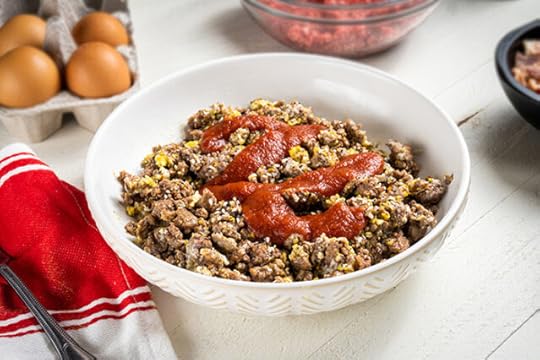
Chop an ounce or two of frozen liver, while it’s still frozen so that it’s easy to work with. Set aside to thaw.
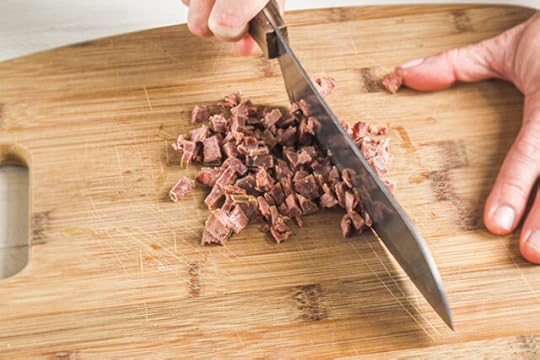
Brown the ground beef in the pan. Use a tablespoon or so of avocado oil in the bottom of the pan if your beef is on the lean side.
Once your beef is 80-90% cooked, add frozen and partially thawed chopped liver.
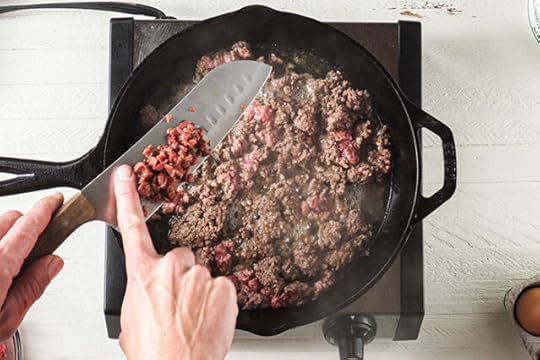
Season the mixture with salt.
Once the beef is cooked through, add eggs for nutrient density and to bind the mixture
together. Sit the eggs on top of the beef to cook most of the way, then break the yolks and mix into the beef mixture when its just about done. The eggs will continue to cook even when they’re off the heat, so this method will prevent overcooking.
Add a scoop of unflavored collagen protein and toss to mix. Sprinkle in your favorite everything bagel seasoning, and top the mixture with unsweetened ketchup.
Teriyaki Carniflex Ground Beef Bowl

Brown your beef and add the liver, as with the basic bowl recipe. Season with salt and kelp flakes for umami flavor and for a boost of natural iodine.
Add the teriyaki sauce, and cook until some of the liquid steams off and it reduces a bit.
Transfer to a bowl, and mix in unflavored collagen protein.
Top with everything bagel seasoning or toasted sesame seeds. Serve as-is for a carniflex dish, or serve with white rice and steamed vegetables for the omnivores in your life.
Buffalo Carniflex Ground Beef Bowl
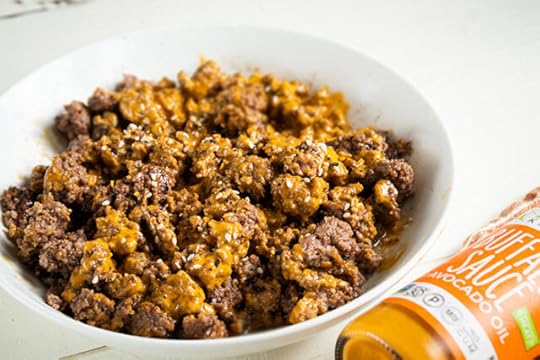
This is the easiest carniflex bowl you’ll ever make. First, Bbrown your beef and season with salt. Transfer to a bowl, mix in collagen protein, and top with buffalo sauce. Easy!
BBQ Bacon Ground Beef Bowl

Brown your beef and add liver. Add your collagen a little earlier this time, once your beef and liver mixture is cooked through. Season with salt and add cheddar cheese and bacon. Quickly move to a bowl so your cheese doesn’t burn. Top with BBQ sauce.
(function($) { $("#df3WjzQ").load("https://www.marksdailyapple.com/wp-ad..." ); })( jQuery ); 
The post 4 Budget Carniflex Recipes: Cost-effective Ground Beef Bowls for the Carnivore Diet appeared first on Mark's Daily Apple.



March 12, 2021
New and Noteworthy: What I Read This Week — Edition 121
Hey folks! You may have noticed something a little different this Friday. Weekly Link Love is now our New and Noteworthy series. We’re following the same format that a lot of you have been reading for over a decade now: it’s a collection of interesting reads I found around the Internet over the week. Enjoy!
 Research of the Week
Research of the WeekKeto may help Covid patients.
Good overview of the health downsides of ingesting foods fried in seed oils.
Both fasting and low-carb reduce liver fat.
Eliminating dairy cows would barely move the climate while having severe impacts on nutrient availability. Pointless and harmful.
Episode 474: Melinda Wittstock: Host Elle Russ chats with Melinda Wittstock, serial entrepreneur and now CEO of Podopolo, a “gamified” podcast network.
Health Coach Radio: Michael Collins talks about the evolutionary wrong turn.
Media, SchmediaScientists like virtual meetings.
Interesting Blog PostsTyler Cowen on vaccine passports.
Google hopes to disrupt college.
Social Notes
Well, how many?
Everything ElseLearning Ancient Greek may cure dyslexia.
Herzegovinian men get their height from their ancient pre-historic hunter genes.
The Neanderthal genomic region associated with protection against severe Covid.
Things I’m Up to and Interested InThis looks bad: Proposed Colorado ballot initiative would criminalize many standard practices small local ranchers use and make meat drastically more expensive.
Cool new service: Own Your Labs.
This is unsurprising: Soil selenium and infection rates.
This is also unsurprising: Vegan diets and bone health.
What low-fat dietary advice triggers in the wild: You end up eating more sugar and more margarine.
Question I’m AskingWhat’s your favorite natural fabric to wear?
Recipe CornerAir fried lollipop chicken with pineapple sauce.This keto tikka masala has a dairy-free option if you prefer.Time CapsuleOne year ago (Mar 5 – Mar 11)
Is Intermittent Fasting Bad for People With Thyroid Issues? – Well, is it?Dear Mark: Going Carnivore with Just Seafood, Protein Right After a Fasted Workout? — Are these good ideas?Comment of the Week
“This will sound weirder than “chicken foot broth”. I’m experimenting with mouth taping while I sleep. I just read “Breath” by James Nestor. It’s fascinating! My sleep has improved, my breathing has improved, and my overall health has improved. And BONUS- I no longer wake up in the middle of the night to go to the bathroom.”
-Yes, mouth-taping is legit, Lisa. There’s no “weird” here.
(function($) { $("#dfDOKIq").load("https://www.marksdailyapple.com/wp-ad..." ); })( jQuery ); 
The post New and Noteworthy: What I Read This Week — Edition 121 appeared first on Mark's Daily Apple.



March 11, 2021
Ask a Health Coach: More of Your Carb Questions Answered
 Hi folks, in today’s Ask a Health Coach, Erin will be answering a few more of your carb-related questions, from knowing which ones to include in your total macro intakes to strategies for managing the aftermath of a carb binge. We love getting your questions, so be sure to post them in the Mark’s Daily Apple Facebook group or in the comments below.
Hi folks, in today’s Ask a Health Coach, Erin will be answering a few more of your carb-related questions, from knowing which ones to include in your total macro intakes to strategies for managing the aftermath of a carb binge. We love getting your questions, so be sure to post them in the Mark’s Daily Apple Facebook group or in the comments below.
Stephanie asked:
When counting carbs, which carbs are counted? Does this include fruits and vegetables too? I realize that all grains and starches should be counted, but does this also include “moderated” foods such as bananas and sweet potatoes? Any advice is appreciated!
As a culture, we’re obsessed with carbs. We’re so totally in love with demonizing, scrutinizing, anddissecting the nuances of carbohydrates. The total carbs, subtracting sugar alcohols and fiber, staking a claim on which carbs are good and which are bad. The whole thing’s gotten really out of hand and way too fussy if you ask me.
I work with a lot of clients who exhibit symptoms of being carbophobic, swearing that low-carb is the answer to all their struggles. Even if you’ve successfully removed the word “diet” from your vocabulary (congratulations, by the way), I find that people absolutely love to have rules around what they should and shouldn’t be eating.
Why Are We So Obsessed with Carbs?
Ever heard of decision fatigue?https://www.medicalnewstoday.com/arti... It’s based on the idea that when making a multitude of decisions (especially in rapid succession), our ability to make additional decisions gets worse. And since we make more than 200 food choices per day, it’s easy to see why having rules takes the edge off.
Types of food decisions you might recognize:
Should I eat breakfast or fast?How much creamer takes me out of ketosis?Should I even have coffee?What about lunch?How many carbs does this have?Is wine okay?And that doesn’t even include the decisions make when dining out, assuming we get to do that more regularly moving forward. The conversations we have in our heads are overwhelming to say the least.
Why? Because our minds prefer things that don’t require a lot of thought. And deciding what we should eat — or how many carbs we should have — is just one more thing to tack onto our to-do lists. Martin Binks, PhD and Director of the Nutrition Metabolic Health Initiative at Texas Tech says, “It’s easier to make a yes or no choice.2 It’s simpler and less stressful to make binary decisions rather than get into nuanced ones,” adding that “food rules can simplify things.” The more variables there are, the harder it is for our brains to make a decision, which at least partially explains our obsession with food rules.
Sure, some structure and guidance is helpful — like knowing which foods agree with your body and which ones make you feel foggy and fatigued. But it’s important to learn how to be flexible and eat mindfully to keep your emotional and physical health on track. The bottom line is, if you just eat real food and don’t waste time overthinking it, you’d likely be in a much better place. When you start loving and appreciating your body for being the magnificent organism it is and stop fussing over counting, weighing and tracking, life gets pretty awesome.
Why Grains Are So Hard to Avoid
Margaret asked:
I lost a ton of weight before and have gained some back after letting carbs creep into my diet again and being sedentary for a period of time. But I’m so stuck on bread, etc. I know once I’m off of it for a while I can resist and not even consider it, but gosh it’s hard to get to that point! How do I get off bread for good? Thankfully, it sounds like don’t need a lesson in why grains can be toxic to your body. But figuring out how to ditch them for good is something a lot of people struggle with, including my own health coaching clients.
Breads, cereals, crackers, and cookies. They’re intricately woven into nearly every aspect of our society. And unless you were brought up on an ancestral kind of diet, your preferences for starchy foods were probably dictated from an early age. In fact, most infants prefer sweet tastes over bitter and sour ones, which may reflect a biological instinct to choose those foods.https://www.sciencedirect.com/science... It’s not just our preferences for starchier foods that keep us stuck on the bread basked rollercoaster though. Research shows that eating the same food as others makes us feel more connected to them. So, if you’re dining with your spouse and they grab a few slices of garlic bread while you whirl around your forkful of zoodles, you may feel like you’re lacking a sense of connection with them. Same thing goes if a friend orders dessert and you abstain.
As humans, we want to feel connected — especially since the past year has made us feel less connected than ever.https://nesca-newton.com/can-i-hug-yo... But food isn’t the only way to get that need met (being of service is actually one of the best ways to feel connected to others).
4 Strategies for Ditching GrainsDitching grains, especially when you know you feel better without them, is absolutely doable with the right strategies. Here are the tips I regularly share with my clients:
Know Your Why. Get clear on your deep-down reasons for not eating bread and other grains. This is a game changer when it comes to navigating the ups and downs of the process, which there will always be.Make Protein and Fat Your Friend. Keeping your blood sugar stable is key to avoiding cravings for quick-burning carbs. I like to start my day with an epic protein forward meal of eggs and bacon.Be Aware of Your Triggers. If bread so tempting that you literally can’t resist it, don’t have it in the house. People who have their favorite foods around “just in case” are asking for an excuse to indulge.Get Support. Being part of a like-minded community, like the one here at Mark’s Daily Apple can be a really valuable resource. For more hands-on guidance, you might also consider hiring a professional health coach.
Dale asked:
I typically keep my carbs under 30 grams and include one cheat meal a week, but last weekend, my one night of pizza and beer turned into a weeklong binge. I’ve also gained about 5 pounds back that I worked so hard to lose. I was so motivated before and now I’m feeling stuck. Why is so hard to get back to my regular routine this time?
Certain foods are designed to be hyper-palatable.https://www.news-medical.net/news/201... Think pizza, chips, fast food. Anytime fat, salt, and highly processed carbs are together in one food, it triggers the reward centers of the brain and can lead to a binge. Food scientists know exactly what they’re doing when they create these foods too. They want you to continue craving, buying, and consuming these foods. Honestly though, a week of overdoing it won’t derail your progress in the long-term. It actually might help you. Here’s why. While I’m not a fan of “cheat days” in general, consuming extra calories might be exactly what your body needs, especially since you’ve been so restrictive with your diet.
How to Move Forward After a BingeYou might expect a health coach to say things like “clear out all the junk food” or “start eating clean again at your next meal.” Those are both great suggestions, but the first thing I’d recommend is to have a little compassion for yourself. My job is to help my clients have an effortless relationship with food. One that doesn’t include guilt, shame, and discouragement. That’s why self-compassion is such an important part of the process. Everyone gets off track now and then. They notice their nightly glass of wine has become 2 or 3 glasses. Or their daily walk has turned in to a weekend-only activity. But having self-compassion means that you’re accepting the fact that you’re human and make mistakes now and then. It also helps you understand that your self-worth isn’t a reflection of how perfect or imperfect you happen to perceive yourself as right now — or what the scale says. If I were you, I’d ditch the scale and start working on acceptance.
Thoughts on carbs? Got more questions? Let’s hear it.
(function($) { $("#dfjIZQF").load("https://www.marksdailyapple.com/wp-ad..." ); })( jQuery ); 
References https://www.medicalnewstoday.com/articles/decision-fatiguehttps://www.depts.ttu.edu/hs/ns/binks...https://www.sciencedirect.com/science/article/pii/S096098221300208Xhttps://nesca-newton.com/can-i-hug-you-why-the-pandemic-has-us-craving-closeness/https://www.news-medical.net/news/20191105/Study-sheds-light-on-unhealthy-hyper-palatable-foods.aspx
The post Ask a Health Coach: More of Your Carb Questions Answered appeared first on Mark's Daily Apple.



March 10, 2021
What Are Branched Chain Amino Acids and Do They Help Muscle Growth and Recovery?
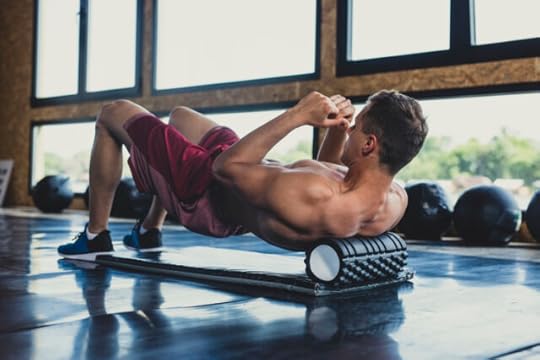 I remember back in the day, you’d see all the bodybuilders at the gym sipping on purple water from those clear shaker bottles. They were drinking water spiked with BCAAs, or branched chain amino acids, the idea being the BCAAs provide your body a steady drip of amino acids to maximize muscle hypertrophy and stay anabolic all day long. Heck, even I sipped the purple water when I was trying to gain mass. In more recent years, BCAAs have fallen out of favor, or at least become less “vital” a supplement for people interested in gaining muscle.
I remember back in the day, you’d see all the bodybuilders at the gym sipping on purple water from those clear shaker bottles. They were drinking water spiked with BCAAs, or branched chain amino acids, the idea being the BCAAs provide your body a steady drip of amino acids to maximize muscle hypertrophy and stay anabolic all day long. Heck, even I sipped the purple water when I was trying to gain mass. In more recent years, BCAAs have fallen out of favor, or at least become less “vital” a supplement for people interested in gaining muscle.
However, branched chain amino acids are still among the most crucial amino acids for human health, metabolism, immunity, and hypertrophy.https://pubmed.ncbi.nlm.nih.gov/29570... Without adequate intake of the BCAAs leucine, isoleucine, and valine, we won’t be able to activate all the metabolic pathways we need to generate energy and utilize macronutrients. Our intestinal health suffers. Our immune system grows sluggish. And, most importantly, without BCAAs we won’t be able to trigger the mTOR pathway necessary for muscle building and repair.
That’s what everyone cares about when they talk about BCAA supplementation: muscle growth and recovery. That’s why the purple water was so common. So, what’s the deal? Do BCAAs work for muscle growth and recovery?
Well, we do need BCAAs. We can’t make them—they are essential amino acids, meaning we must obtain them from outside sources rather than manufacture them in-house. We must eat them.
But do we have to sip the purple water? Must we supplement BCAAs?
Let’s find out.
What Are BCAAs Made Of?
When most people talk about BCAAs, they’re talking about leucine. If you had to choose one amino acid for building muscle, it would be leucine. Leucine activates mTOR, or mammalian target of rapamycin, the physiological pathway required for muscle protein synthesis. Simply ingesting leucine has been show to upregulate mTOR and muscle protein synthesis in people. If you pair leucine with some resistance training, the effect is even greater.
Leucine is the amino acid vegans and (often) vegetarians are usually missing, as plant foods contain very little. You can get there if you utilize specially-formulated plant protein powder blends (or eat straight up vital wheat gluten), but if you go with whole plant foods alone you’d be hard pressed to get enough leucine—over 800 calories of peanuts or 3600 calories of wheat bread are required to get just 2.5 grams of leucine.
On the other hand, animal foods are the richest sources. 23 grams of whey protein isolate (92 calories), 142 grams of top round (391 calories), or 142 grams of chicken breast (147 calories) are animal-based ways to get 2.5 grams of leucine. Dairy, eggs, and other animal foods are also great sources. It’s way easier to get enough BCAAs from your diet if you eat meat, and most prolific meat-eaters are going to be getting plenty of BCAAs simply from their diet.
So if you’re reading this, and you’re eating meat, eggs, dairy, and other animal foods on a regular basis like most readers and visitors to this site, you’re probably getting enough BCAAs to take care of your requirements. You probably don’t need to supplement with additional BCAAs.
However, there are some people who should definitely take BCAAs.
When Does It Make Sense to Take BCAAs?There are a few different situations where supplementing with BCAAs can help you achieve your goals and recover more quickly:
You’re vegan.You train fasted.You’re on a calorie-restricted diet.You’re recovering from an injury, illness, or bedrest.You want to get back into competition or training more quickly.You’re vegan.Sure, you could live off soy protein powder. Sure, you could sprinkle pea protein powder into everything you eat and drink. But if you want to eat a more whole foods-based vegan or vegetarian diet, adding a serving or two of BCAAs directly will give you more leeway. I still wouldn’t advise this, but if you’re dead-set on it, include some BCAAs.
You train fasted.If you’re doing fasted weight training, it would be prudent to take 10-15 grams of BCAAs before the training session. For one, they are muscle-sparing, especially during intense resistance training.https://www.ncbi.nlm.nih.gov/pubmed/7... The last thing you’d want during a fasted workout is for your body to start breaking down muscle to create glucose. Taking them before a fasted workout would be more effective than after, though if you were planning on continuing the fast post-workout, more doses on the hour should prevent muscle breakdown until you’re able to eat some real food.
And two, BCAAs taken during and after a strength training session augment the normal mTOR boost in muscle tissue resulting from training alone.https://journals.physiology.org/doi/f...
BCAAs will turn off the autophagy induced by fasting, but if you’re trying to build muscle, by necessity you must halt autophagy. Plus, it’s the end of the fast so you were already going to turn it off anyway.https://www.ncbi.nlm.nih.gov/pubmed/2....
You’re on a calorie-restricted diet.The worst part about a diet is the lean mass you can lose. It’s not “weight” we want to lose, it’s fat. We’d prefer to maintain or even gain lean mass, and BCAAs can help.
Young adults on a calorie restricted diet were split into one of two groups: a BCAA group or a carb group.https://pubmed.ncbi.nlm.nih.gov/26733... Both groups lifted weights throughout the study. The group who took BCAAs lost fat mass and retained lean mass. The group who took carbs lost weight but not fat mass—only lean mass. Thus, BCAAs didn’t promote “weight loss” but they did promote fat loss. Carbs promoted “weight loss” but not fat loss.
You’re recovering from an injury, illness, or bedrest.Recovering from injuries, surgeries, bedrest, or illness requires a lot of amino acids, especially the BCAAs, which help make the necessary repairs. You haven’t been exercising. You haven’t been eating right. Your tissues (not just your muscles) have been atrophying. A lot has gone wrong, and you need to rebuild. That takes extra amino acids, and that’s where supplementing with BCAAs has been shown to help.
In stroke patients, adding BCAAs to their breakfast makes lifting weights later in the day more anabolic, leading to improved body composition.https://pubmed.ncbi.nlm.nih.gov/32610...
Another study in stroke patients had similar results. In that one, Both groups ate the same food provided by the hospital, both were calorie-matched and of similar baseline status, only the interventional group got a BCAA supplement. What’s remarkable is that the BCAA dosage was relatively modest—just 1.2 grams of “extra” leucine per day. And it was still enough to increase muscle strength and muscle mass.https://pubmed.ncbi.nlm.nih.gov/30273...
How about patients with sarcopenia—muscle wasting? Giving a BCAA supplement (plus vitamin D and exercise) to sarcopenic older adults staying in a hospital setting improved their strength gains; those who did not receive BCAAs (but still exercised) had impaired gains.https://pubmed.ncbi.nlm.nih.gov/30358...
After surgery, which is pretty much a controlled wounding, protein intake is probably the most crucial aspect of the patient’s nutrition and subsequent recovery. Many doctors recommend that surgical patients take whey protein isolate—the richest source of BCAAs in the diet—for a couple days after a procedure.
You want to get back into competition or training more quickly.If delayed onset muscle soreness (DOMS) is holding you back from training, BCAAs can be very helpful. A recent meta-analysis concluded that a “large decrease in DOMS occurs following BCAA supplementation after exercise compared to a placebo supplement.”https://pubmed.ncbi.nlm.nih.gov/30938...
Should Healthy People Supplement with BCAAs?What about healthy people who eat three meals a day, lift weights in a fed state, and just want a boost to their muscle growth? Can BCAA supplements help them?
They can’t hurt. BCAAs are useful. Your body will use them if you provide them. They’re pretty helpful for reducing DOMS (delayed onset muscle soreness) and they do increase mTOR, which is helpful for muscle protein synthesis. They just don’t seem to be essential in the context of adequate animal protein.
For example, in one recent study, BCAAs moderately reduced post-workout muscle soreness following eccentric exercise training (lowering the weight), but the effects on force production and performance were negligible as long as the subjects ate enough protein—1.2 grams of protein per kilogram of bodyweight, to be exact.https://pubmed.ncbi.nlm.nih.gov/30275...
Besides, you could just take whey isolate. Whey protein isolate will accomplish pretty much the same thing as BCAAs because it’s a rich source of BCAAs, plus other essential amino acids. 25 grams of whey protein isolate, remember, gets you the 2.5 grams of leucine that’s proven to be so helpful for muscle growth. I’ve spoken at length about the impressive benefits of whey protein in the past for both muscle growth and general health.
To sum up, certain conditions and situations call for extra BCAAs through direct supplementation (or whey isolate), while most healthy people do not need to take them as long as they eat enough dietary protein.
Now let’s hear from you. Do you take BCAAs? What kind of benefits do you see?
(function($) { $("#dfbPqaG").load("https://www.marksdailyapple.com/wp-ad..." ); })( jQuery ); 
The post What Are Branched Chain Amino Acids and Do They Help Muscle Growth and Recovery? appeared first on Mark's Daily Apple.



March 9, 2021
9 Ways to Customize Your Keto Diet
 The keto diet has a reputation for being strict and regimented. Some guidelines you do have to follow, particularly concerning carbohydrate intake. However, just as a Primal diet allows plenty of room for personalization based on food preferences, goals, activity level, and more, keto diets can actually be quite flexible.
The keto diet has a reputation for being strict and regimented. Some guidelines you do have to follow, particularly concerning carbohydrate intake. However, just as a Primal diet allows plenty of room for personalization based on food preferences, goals, activity level, and more, keto diets can actually be quite flexible.
In fact, once you’ve successfully made the transition to keto, I think you should make adjustments to ensure your diet feels sustainable and works for your life.
That said, all of the suggestions below are totally optional. They aren’t inherently better than whatever you’re doing now. If you’re happy with your current diet, there’s no need to change it. I know, though, that many of us in the MDA community are questioners or enthusiastic self-experimenters, always up for trying something new and looking for ways to tweak and optimize our diets and lifestyles.
I’m all for self-experimenting and developing your personal expression of keto, one that you find easiest and most enjoyable. So, without further ado, here are nine things you can do to personalize your keto diet.
9 Ideas for Creating a Custom Keto Diet1. Increase Carbohydrate IntakeThe Keto Reset recommends a carb intake of about 50 grams per day (total, not net) for most people, perhaps down to 30 grams for folks who are sedentary or insulin resistant.
Other keto protocols recommend capping carb intake at 20 grams or less. That’s tough to do unless you’re sticking to a fairly limited range of foods. A small handful of macadamia nuts or blueberries represents a quarter of your daily carb allowance if you’re trying to stay under 20 grams. One big-ass salad can put you near or even over your limit.
Some people need to keep carbs that low for medical reasons. There’s no need for the rest of us to be that restrictive, especially not if it makes your diet difficult and unenjoyable.
Even 50 grams may be overly conservative for some people. Athletes and other very active folks can probably go above 50 grams per day and still stay in ketosis, especially if they time their carb intake around training.
2. Decrease Carbohydrate IntakeIn the Keto Reset community, I see fewer people overeating carbs than restricting carbs unnecessarily. Still, there are a few reasons someone might want to consider decreasing their carb intake:
To increase ketone levels for specific medical purposes (on the advice of a doctor or nutritionist) or as a self-experimentStill experiencing unwanted sugar cravingsDealing with insulin resistance or poor glycemic controlTrending toward a carnivore or carniflex approach3. Increase Protein IntakeJust a few years ago, the prevailing wisdom was that protein intake should be kept to low-to-moderate levels on a keto diet. Now, a growing number of folks who identify as keto are eating meat-centric or entirely carnivorous diets.
Anecdotally, many people feel better, experience greater satiety, and have an easier time losing weight when they increase their protein intake (if they were on the lower end to start). The majority of people find their protein sweet spot somewhere in the range of 0.7 to 1.0 grams of protein per pound of lean body mass. Highly active folks, older individuals, and people looking to gain lean mass should aim for the higher end or perhaps a bit over.
There’s no need to force protein. Above a certain threshold, around 0.8 grams per pound of total body weight, eating more doesn’t seem beneficial, at least not for gaining muscle and strength.https://pubmed.ncbi.nlm.nih.gov/28698... All things considered, though, it’s better to take in a little more than we need than to undereat protein, especially as we age.
4. Change Up the Sources of Fat in Your DietOne of the most controversial aspects of ketogenic diets is that they can raise LDL cholesterol. I know many readers here are skeptical of the conventional lipid hypothesis of heart disease, so you might not think this is a big deal. However, lots of people—and lots of people’s doctors—freak out when they see LDL jump after going keto.
This is obviously a huge topic, far too complex to hash out today. For now, let me just say the evidence regarding keto diets’ effects on LDL is mixed. Even if you believe that LDL (or LDL-p) is a risk factor for cardiovascular disease, it remains to be seen whether high LDL confers the same risk in the context of a low-carb, high-fat diet as it does in the context of a pro-inflammatory SAD diet.https://www.ncbi.nlm.nih.gov/pmc/arti...
That said, if you or your doctor is concerned because your LDL rose significantly, especially if it remains high after the first six months on keto, look at the fat composition of your diet. Keto diets with more saturated fat could lead to greater increases in LDL.https://www.ncbi.nlm.nih.gov/pmc/arti... It might be worthwhile to drop the fatty coffees, swap some of the bacon grease for avocado oil or olive oil, and see what happens.
5. Experiment with Carb TimingThere are two main reasons you’d want to do this: One, you’re trying to manage blood glucose levels. Glucose tolerance tends to decrease over the course of the day and be poorest in the afternoon or early evening. The same is probably true for insulin sensitivity, though the evidence here isn’t quite so straightforward.https://academic.oup.com/edrv/article... Try eating more of your carbs earlier in the day to see how your glucose levels respond. This is also an interesting experiment if you’re wearing a continuous glucose monitor for self-quantification purposes.
The other reason is sleep. Sleep disruptions, especially waking in the middle of the night, are somewhat common when people first switch to keto. Some folks swear that they sleep better when they eat most of their carbs at dinner.
6. Try Carb CyclingCarb cycling is a catch-all term for incorporating periods of higher-carb eating into your keto diet. This might look like:
Eating one or two high-carb meals per weekEating keto macros during the week and loosening the reins on the weekendBeing keto for a set time, say six or eight weeks, and then eating a “regular” diet for a week or twoFor females, eating more carbs at certain points of their menstrual cyclesFor athletes, varying carb intake according to where they are in their training regimenThese strategies can be worthwhile for folks experiencing increased hunger, menstrual irregularities, or stalled weight loss, which can all be signs of leptin resistance. Athletes whose performance or motivation is suffering could also try cycling in some carbs.
Check out Mark’s Definitive Guide to Carb Timing and Carb Cycling for more information about how this works.
7. Go Dairy-freeI know cheese lovers in the crowd don’t want to hear this.
When someone complains of any issue that could possibly have an inflammatory component—autoimmune symptoms, joint pain, brain fog, skin problems, fatigue—the first thing I ask is if they’ve tried eliminating dairy. In my experience, of all the variables you might tweak, this is the one that can be most impactful… and the one people are most reluctant to try.
I get it, I love my creamy morning coffee too. However, if your keto diet isn’t getting hoped-for results, I strongly encourage you to try a period of dairy-free eating. If nothing has improved after a few weeks, you can always add it back.
8. Try Intermittent FastingYou’re probably already aware of the myriad benefits of intermittent fasting. (If not, Mark has a new book coming out called Two Meals a Day that you’ll want to check out.) Fasting is not required to do keto “correctly,” but they’re highly compatible. Both can contribute to insulin sensitivity, glycemic control, reduced inflammation, mitochondrial health, fat loss, appetite regulation, and autophagy.
The easiest way to start is by eating when hunger ensues naturally rather than sticking to set eating times. You’ll likely find that you naturally eat in a window of 6 to 12 hours because you just aren’t as hungry on keto.
9. Change Your Eating WindowAlready intermittent fasting? Try lengthening or shortening your eating window, or shift it to a different time of day.
Most people start by skipping breakfast, but eating earlier in the day might be preferable from a circadian rhythm perspective. Research suggests that early time-restricted feeding (eTRF) promotes better glycemic control and insulin sensitivity, improved beta cell function, less inflammation, and even anti-aging benefits.https://www.ncbi.nlm.nih.gov/pmc/arti... https://www.ncbi.nlm.nih.gov/pmc/arti...
Early time-restricted feeding means having breakfast and lunch or a mid-afternoon meal, then skipping dinner. Since hunger tends to be lower in the morning, especially if you’re used to skipping breakfast, you’ll have to start by eating when you’re not actually hungry. It might feel wrong, but your hunger will soon adjust to your new eating schedule. Give this experiment at least a few weeks before deciding if you like it or not.
Who Should Try These?Everyone should feel empowered to experiment with their diet, keto or otherwise, and customize it to work for them. I’m not saying you have to try the specific ideas above, but you certainly could, especially if you’re:
Finding keto to be too restrictiveNot getting the results you wantedBored with your current way of eatingMotivated to get the most out of your dietLooking for a sustainable long-term diet that suits your tastes and lifestyleAs an evergreen reminder, though, if your current diet isn’t working as you hoped, it might not be about the food. Food is only one piece of the puzzle for any health, fitness, longevity, or general wellness goal. Your diet might not be working because you aren’t getting enough sleep, your stress bucket is overflowing, or you’re spending too much time sitting at your desk and not enough moving and getting fresh air and sunshine. Remember, food only represents two of the ten Primal Blueprint Laws, and they all work synergistically to build health.
(function($) { $("#dfFWako").load("https://www.marksdailyapple.com/wp-ad..." ); })( jQuery ); 
References https://pubmed.ncbi.nlm.nih.gov/28698222/https://www.ncbi.nlm.nih.gov/pmc/articles/PMC6173254/https://www.ncbi.nlm.nih.gov/pmc/articles/PMC5452247/https://academic.oup.com/edrv/article/18/5/716/2530790https://www.ncbi.nlm.nih.gov/pmc/articles/pmc5990470/https://www.ncbi.nlm.nih.gov/pmc/articles/PMC6627766/
The post 9 Ways to Customize Your Keto Diet appeared first on Mark's Daily Apple.



March 6, 2021
Keto and Gluten Free Chocolate Chip Cookies
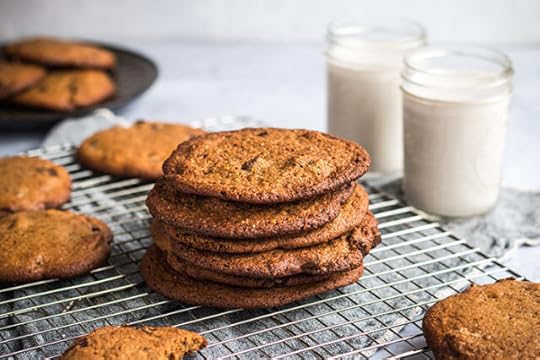 Is there anything more nostalgic than a chocolate chip cookie with a tall glass of milk? If you thought a cookies and milk snack was a thing of the past, we’ve got you covered. This keto chocolate chip cookies recipe is just as satisfying as the cookies you remember from Grandma’s kitchen. And, they’re totally dunk-worthy, so have a glass of milk, almond milk or macadamia nut milk ready when they come out of the oven.
Is there anything more nostalgic than a chocolate chip cookie with a tall glass of milk? If you thought a cookies and milk snack was a thing of the past, we’ve got you covered. This keto chocolate chip cookies recipe is just as satisfying as the cookies you remember from Grandma’s kitchen. And, they’re totally dunk-worthy, so have a glass of milk, almond milk or macadamia nut milk ready when they come out of the oven.
The combination of almond flour and coconut flour maintains a chewy texture. If you prefer your cookies flatter and crunchier or fluffier and lighter, I included ways to adjust your baking soda and baking powder to achieve the cookie style you remember eating as a kid.
Let’s make your new favorite chocolate chip cookie recipe.
How to Make Keto and Gluten-free Chocolate Chip Cookies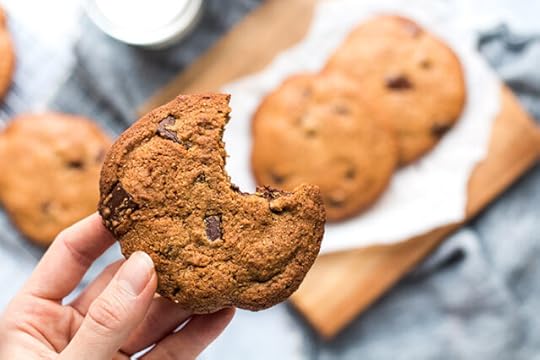 Ingredients1/4 cup softened and room temperature
Ingredients1/4 cup softened and room temperaturesalted butter1/4 cup almond butter1/2 Tbsp. vanilla extract1/2 cup granulated monkfruit sweetener (or coconut sugar if not keto)2/3 cup + 1 tbsp. almond flour2 tsp. coconut flour1/2 tsp. baking powder (or for a flatter, crunchier cookie, use ¼ tsp. baking soda
and 1/4 tsp. baking powder)1 large egg120g chopped dark chocolate (we used 85%)
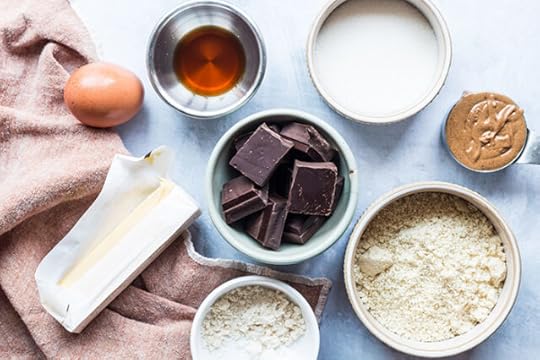
Preheat your oven to 350 degrees Fahrenheit. In a bowl, combine the soft butter, almond butter and vanilla extract. Mix in the sweetener, almond flour and coconut flour. Whisk the egg and mix it into the dough.
 Allow the dough to rest for 3-5 minutes, then mix in the baking powder.
Allow the dough to rest for 3-5 minutes, then mix in the baking powder.
Chop your chocolate and fold it into the dough.
 Use an ice cream scoop to scoop out 8 balls of dough onto a parchment covered baking sheet.
Use an ice cream scoop to scoop out 8 balls of dough onto a parchment covered baking sheet. 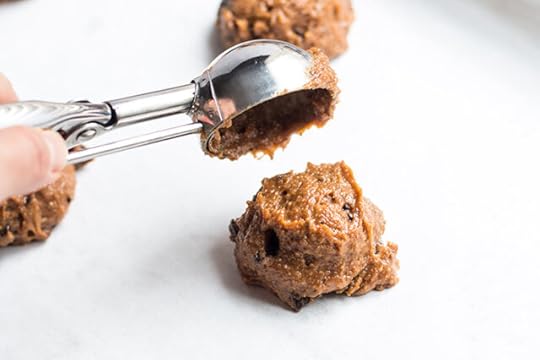 Bake for 11-14 minutes, or until the undersides of the cookies are just golden. Allow them to cool slightly prior to moving them to a cooling rack.
Bake for 11-14 minutes, or until the undersides of the cookies are just golden. Allow them to cool slightly prior to moving them to a cooling rack.

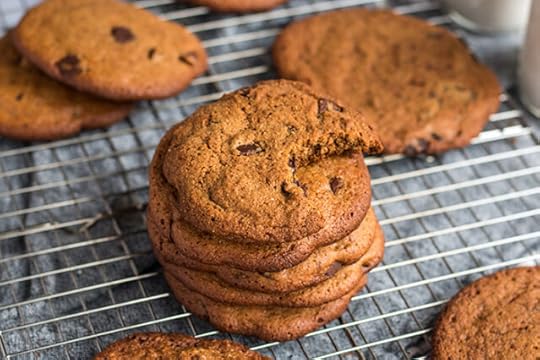

(function($) { $("#dfYDa3V").load("https://www.marksdailyapple.com/wp-ad..." ); })( jQuery ); 
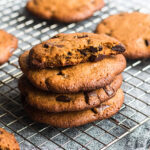 Keto and Gluten Free Chocolate Chip Cookies Author: Courtney Sperlazza
Keto and Gluten Free Chocolate Chip Cookies Author: Courtney Sperlazza  Prep Time: 10 min
Prep Time: 10 min  Cook Time: 14 min
Cook Time: 14 min  Total Time: 24 min
Total Time: 24 min  Yield: 8 cookies Diet: Gluten Free
Yield: 8 cookies Diet: Gluten Free  Print Recipe
Print Recipe  Pin Recipe Description
Pin Recipe Description Bakery-style chocolate chip cookies made with almond and coconut flour and sweetened with monk fruit for a totally indulgent low-carb, gluten-free treat!
Ingredients1/4 cup softened and room temperature salted butter
1/4 cup almond butter
1/2 Tbsp. vanilla extract
1/2 cup granulated monkfruit sweetener (or coconut sugar if not keto)
2/3 cup + 1 tbsp. almond flour
2 tsp. coconut flour
1/2 tsp. baking powder (or for a flatter, crunchier cookie, use ¼ tsp. baking soda and ¼ tsp. baking powder)
1 large egg
120g chopped dark chocolate (we used 85%)
InstructionsPreheat your oven to 350 degrees Fahrenheit. In a bowl, combine the soft butter, almond butter and vanilla extract. Mix in the sweetener, almond flour and coconut flour. Whisk the egg and mix it into the dough. Allow the dough to rest for 3-5 minutes, then mix in the baking powder.
Chop your chocolate and fold it into the dough. Use an ice cream scoop to scoop out 8 balls of dough onto a parchment covered baking sheet.
Bake for 11-14 minutes, or until the undersides of the cookies are just golden. Allow them to cool slightly prior to moving them to a cooling rack.
NotesDifferent brands of coconut flour can vary in absorbancy. For this recipe I used Whole Foods brand Coconut flour. You may want to start with 1 teaspoon of coconut flour and allow the dough to rest for a few minutes to thicken up, and then adjust up to 2 teaspoons based on the thickness of the dough.
If you’re not Keto or don’t want to use a sugar substitute, this recipe is excellent with coconut sugar. Just sub the sweetener 1:1.
For flatter, crunchier cookies, use ¼ tsp. baking powder and ¼ tsp. baking soda. For a slightly fluffier cookie that doesn’t flatten out, use ½ tsp. Baking powder.
For this recipe, we recommend either roughly chopping up your favorite dark chocolate bar, or using chocolate chunks.
 Category: Dessert
Category: Dessert Method: Baking Nutrition Serving Size: 1 cookie Calories: 88 Sugar: .7g Sodium: 11 mg Fat: 8.3g Saturated Fat: 4.2g Unsaturated Fat: 4.1g Trans Fat: 0g Carbohydrates: 2g Fiber: 0.7g Protein: 1.7g Cholesterol: 39 mg
Method: Baking Nutrition Serving Size: 1 cookie Calories: 88 Sugar: .7g Sodium: 11 mg Fat: 8.3g Saturated Fat: 4.2g Unsaturated Fat: 4.1g Trans Fat: 0g Carbohydrates: 2g Fiber: 0.7g Protein: 1.7g Cholesterol: 39 mg Keywords: gluten free chocolate chip cookies recipe, keto chocolate chip cookies recipe, grain free chocolate chip cookies recipe,
 Did you make this recipe?
Did you make this recipe? Share a photo and tag Mark's Daily Apple — we can't wait to see what you've made!
How many carbs are in a chocolate chip cookie?The carb count in traditional chocolate chip cookies varies, as cookies vary in size and sugar content. These cookies contain less than 2g of net carbs each.
Does that mean you can have cookies for breakfast? That’s entirely up to you!
Can you freeze chocolate chip cookies?You can freeze these cookies, but they may take on that freezer taste and a crumbly texture. It’s best to eat them fresh. The best way to freeze this cookie recipe is to put unbaked dough into parchment paper and roll into a long tube, then freeze. When you’re ready to bake them, take the dough out in the morning, and once the dough has softened, drop them onto a baking sheet. Bake, and voila, you have fresh keto chocolate chip cookies.
The post Keto and Gluten Free Chocolate Chip Cookies appeared first on Mark's Daily Apple.



March 5, 2021
Weekly Link Love — Edition 120
 Research of the Week
Research of the WeekVery low-carb ketogenic diets are safe and effective for type 2 diabetics.
Both Neanderthals and humans had similar auditory and speech capabilities.
The link between air pollution and crime.
2020 saw the highest number of traffic deaths in 13 years, despite driving being way down.
Improving road safety reduces crime.
Episode 473: Drew Manning: Host Elle Russ welcomes Drew Manning back to the podcast.
Health Coach Radio: Chris Davis and Stephanie Aubrey show you how to grow stronger through collaboration.
Media, SchmediaThe COVID epidemic hit obese countries hardest.
Interesting Blog PostsDave Feldman digs into a little-used measure of lipoprotein oxidation.
How close are we to psilocybin and MDMA therapy?
Social NotesEverything ElseA true flower child.
New embalming details from an ancient Egyptian manual reveal how sophisticated those guys were.
Things I’m Up to and Interested InReasons why young adults might be having less sex: Video games, lower alcohol consumption, living with parents.
Interesting article: Cormac McCarthy on the evolution of language.
If you’re qualified…: Apply to revive the woolly mammoth.
Big topic: “Prevalence trends tell us what did not precipitate the US obesity epidemic.”
Missing vitamin D?: This sunlamp looks quite good.
Question I’m AskingWhat do you think caused the obesity epidemic?
Recipe CornerCauliflower colcannon looks incredible.Indian fish curries are some of my favorite and very underrated.Time CapsuleOne year ago (Feb 26 – Mar 4)
The Foolproof Way to Increase Your Odds of Reaching Your Goals – Make it (more likely to) happen.Why I Eat Organ Meat Weekly, and You Should Too — Why Terry Wahls does it.Comment of the Week
“This column comforts, but also inspires. I’m caregiving my bedridden husband right now, and have been so tired that my emotions have played havoc. But this steadies and provides a goal I can concentrate on. It has helped already. Thank you!”
-I’m so glad to hear this, Helen.
(function($) { $("#dfg0tga").load("https://www.marksdailyapple.com/wp-ad..." ); })( jQuery ); 
The post Weekly Link Love — Edition 120 appeared first on Mark's Daily Apple.



March 4, 2021
How to Create a Powerful Morning Routine (And the Surprising Reasons You’ll Want To)
 How often do you find yourself mashing the alarm clock, desperately longing for a few more glorious minutes of shut eye? A couple days a week? Every day? Not sure why you’d ever NOT want to mash the alarm?
How often do you find yourself mashing the alarm clock, desperately longing for a few more glorious minutes of shut eye? A couple days a week? Every day? Not sure why you’d ever NOT want to mash the alarm?
For a lot of us, working from home has allowed for a much more relaxed morning routine. And by relaxed, I mean sleeping right up until the last minute, throwing the covers off, throwing a decent-looking top on, and scarfing down a bar or several cups of coffee as you scramble to log on to your first Zoom call.
Sound familiar?
When you start your morning like a fire drill, guess what happens? The whole day follows suit. Every minute feels like you’re playing catch up. Things tend to fall through the cracks with zero chance of regaining control. And all of your good intentions – you know, preparing a healthy protein-forward breakfast and getting outside for some fresh air quickly become a task for another day when it’s less busy.
Why a Morning Routine Helps You Crush ItBesides the obvious reason (see above), having a solid morning routine sets the tone for your entire day. No matter what happened yesterday or what’s on your schedule for today, a morning routine is a constant you can rely on — something that allows you to assert your authority over the day. It’s a ritual you’ve consciously carved out time to do in the name of self-care and sanity, because you value your health, happiness, and general wellbeing.
Take a look at people who are known for totally crushing it. You’ll notice they all have something in common:
Tim Ferriss starts every day by making his bed, because it’s a simple action he can take that gives him a feeling of pride and accomplishment. Plus, it’s something he can do that’s totally within his control.Julianne Hough swears by her morning gratitude ritual, which includes thinking of five things she’s grateful for and setting small spiritual goals for the next 24 hours.Even former president Obama has a routine, beginning each day with a workout, followed by breakfast with his kids.It’s not just the entrepreneurial, celebrity, and political set who are privy to creating such a routine. In fact, that’s one of the first things I recommend my clients do when we start working together. When you take the time to create a morning routine that means something to you, you decide that you’re worth putting yourself first.
You decide that you’d rather be proactive about your day instead of reactive. What do I mean by proactive vs. reactive?
What being proactive looks like:
Staying actively engagedFeeling a sense of clarity and controlKnowing what’s important to youLooking ahead and anticipating your needsWhat being reactive looks like:
Letting circumstances control youFeeling helpless or threatenedNeglecting your own needsTaking action without thinking things throughToo Busy to Get Up Early? Read ThisIf you’re someone who works the early shift or can’t bear to make extra time in the pre-dawn hours, I get it. But here’s the thing. No one said your routine had to take up a major chunk of your morning. Some of the best routines require no more than 5 minutes and can seriously transform your day from feeling like you’re running on empty to feeling strong and fulfilled.
There’s plenty of scientific evidence to back it up too. According to this study published in The Journal of General Psychology, early-risers are known to procrastinate less than their snooze-button-pushing cohorts.https://pubmed.ncbi.nlm.nih.gov/18649... And routines that include meditation can lead to improved brain function as seen in this study, where researchers from Canada and Germany analyzed 21 studies and found that people who meditated regularly had changes in regions of the brain associated with things like self-control, emotion regulation, and memory.https://pubmed.ncbi.nlm.nih.gov/24705...
What’s the Best Morning Routine?I can’t tell you how many articles I’ve seen arguing that warm lemon water or a cold shower is the best way to start the day. Everyone is different with different biological rhythms, preferences, and styles. That being said, the most effective morning routine you can do is one that’s tailored specifically to you – one that delivers results you personally find meaningful.
Here are the exact questions and strategies I use with my clients to help them create a morning routine that’s practical, beneficial, and most importantly, makes them want to jump out of bed in the morning (yes, it’s possible).
1. Ask: What do I want more of in my day?Honestly, when I pose that question, I usually get a blank stare in return. A lot of people operate on autopilot the minute they crack open their eyes. But you actually have a say in how you want to feel throughout your day. And your morning routine is the best time to set the tone for that feeling. Your routine could include one thing or a series of things, depending on how much time you want to devote to it.
Examples: If you want to feel more energized, include some form of movement in the morning: yoga, stretching, going for a run; to feel more grounded, try meditation, reading, or journaling; to feel more organized, make your bed, cook up a quality breakfast, or tidy up your workspace. For more morning routine ideas, check out this list.
2. Ask: What might get in the way?If there was nothing currently standing in your way, you wouldn’t still be here reading this article (note: these *things* sound a lot like excuses). Take a minute to look at your mornings right now and get a clear picture of any obstacles that might prevent you from your new routine, then take steps to address them.
Examples: If your kids need help getting ready for school, start your morning routine earlier or ask your spouse to take on that task; if the alarm clock is within smashing distance, find a better place for it like in the bathroom.
3. Ask: What drains me?Think about the activities that cause you stress or make you feel drained. You know, checking emails, reading news headlines, scrolling through social media. These are the LAST things you’d want to include in your morning routine. You always have a choice, and if certain behaviors make your day start off on the wrong foot, ditch ‘em.
Examples: Save your emails for when your workday officially begins; delete Instagram and TikTok from your phone; and become aware of the habits you have that are chronically working against you.
4. Ask: What leaves me feeling inspired?Remember, this is YOUR time to do the things that light you up. Things that are worth infusing into your mornings so that you feel more focused, more energized, or even get you closer to your health goals. This is the time to be selfish. It’s not a to-do list, so please no “folding laundry” or “washing dishes” unless that excites you.
Examples: You might find that you love the quiet hours of the morning to draft a few pages of that book you’ve been dreaming about writing; or maybe you can’t get enough of the clarity you experience when you meditate. Whatever that is, do it. And do it regularly.
5. Ask: What’s my schedule like?This question is more logistical, but I’d argue that it’s just as important as the other four questions on this list. If you have a schedule that’s pretty consistent, like a 9 to 5 job, figure out how long your morning routine will take you, then back it out from your hard stop. If your schedule is more organic, commit to a timeframe that will work for you regardless of when you need to be somewhere.
Examples: Say your first call is always at 9am. Decide what time you’d need to get up to be ready for your day, and how long your morning routine will comfortably take you, then set your alarm for that time – without pressing snooze.
You always have a choice how you start your morning, no matter how much time and how many responsibilities you have. It’s the difference between feeling a sense of peace and control (even if it is for just a few minutes) and letting your circumstances rule your day. Ready to create your solid morning routine? Get started by asking yourself these questions:
What do I want more of in my day?What might get in the way?What drains me?What leaves me feeling inspired?What’s my schedule like?Do you have a morning routine? If so, what does yours look like?
(function($) { $("#dfoTReq").load("https://www.marksdailyapple.com/wp-ad..." ); })( jQuery ); 
References https://pubmed.ncbi.nlm.nih.gov/18649490/https://pubmed.ncbi.nlm.nih.gov/24705269/
The post How to Create a Powerful Morning Routine (And the Surprising Reasons You’ll Want To) appeared first on Mark's Daily Apple.



March 3, 2021
What to Do About Maskne
 Pandemic life comes with a lot of things to deal with that we’ve never had to think about before. One of those things is “maskne,” or acne around the mouth and nose caused by wearing masks for prolonged periods of time.
Pandemic life comes with a lot of things to deal with that we’ve never had to think about before. One of those things is “maskne,” or acne around the mouth and nose caused by wearing masks for prolonged periods of time.
Before we get into the causes and solutions, let me point out that this article is here to offer possible solutions for people who are dealing with mask-related acne. I won’t be addressing whether masks are warranted or recommended or any of that – you’d be better off discussing that with a virologist or immunologist. Not me. This article is for people who have to wear or choose to wear masks, and want to address skin irritation that may have cropped up because of them.
So let’s get to it. Let’s try to figure out some solutions to this new and growing problem.
First of all, what is maskne?The technical term for maskne is acne mechanica — clogged pores and pimples caused by friction and rubbing. Before this past year, most acne mechanica was caused by wearing sports equipment, bras, goggles, belts, and other things worn tight against the skin. All that changed with the pandemic. Never before in the history of the world had normal people been asked to affix masks over their nose and mouth for the majority of the day. Not only that, but often the same mask that you hastily dug out of your pockets, still greasy from the last time you wore it.
The big problem with tackling maskne is that it’s a new kind of acne mechanica (before mask-wearing became widespread, most cases were on other areas of the body) and the only research specifically geared toward it is observational. There are no controlled trials. There is just a flood of anecdotes that clinicians and researchers are wading through.
What can you do about it?
Try different masks.Maskne is more than the friction. It can also be an immune reaction to the mask material. It’s also the lack of oxygen, the lack of air flow, the moisture build-up, the bacterial load accumulating. Different masks have different issues.
N95 masks are tight against the face and restrict air flow (by design). Things get hot and humid in there, and where the actual mask makes contact with your skin, the pressure is great enough to leave welts or bruises and stimulate true acne mechanica.
Disposable surgical masks aren’t as tight, but they’re tight and impermeable enough to create issues.
Cloth masks let air flow, for better or worse, but they also accumulate a lot of grease, grime, and bacteria.
Silk masks are also much easier on the skin, but their ability to filter viral particles is questionable at best.
Point being: all masks are potentially an issue. Try different types made from different material to figure out the issue.
Take frequent mask breaks.
Sometimes you have to wear the mask. Sometimes there’s just no getting around it, whether because of safety indoors or rules you must follow. If that’s the case, do your best to take breaks as often as possible. The American Academy of Dermatology Association recommends a 15 minute break every 4 hours, which is woefully inadequate in my opinion. Better is as often as you can.
Maybe it means pulling the mask down when there’s no one around or stepping outside to take an extended mask-free break.
Handle the basics.Acne is ultimately an inflammatory condition. While mechanical maskne isn’t quite the same as hormonal or “internal” acne, it’s a safe bet to assume that you should at least shore up all the things that have shown to affect the latter.
Eat plenty of zinc (red meat, oysters, organ meats).
Get enough omega-3s: EPA (a long chain omega 3 found in marine foods) is usually lower in people with acne.https://pubmed.ncbi.nlm.nih.gov/28025... Eat fish or take fish oil.
Control your insulin: Since insulin can stimulate IGF-1 production, which in turn increases sebum production in the skin, chronically high insulin levels can cause clogged pores. Recent studies done during the COVID pandemic have found that acne and other inflammatory skin conditions are worse in patients with insulin resistance.https://pubmed.ncbi.nlm.nih.gov/32969... Funny how insulin keeps popping up, eh?
Try a mask bracket.A mask bracket is a small accessory worn on the inside of your mask that creates airspace between your skin and the cloth. It may be just what you need to reduce friction and help with airflow near your mouth and chin, where mask-related breakouts are likely to occur.
Take sun breaks, take vitamin D.A traditional treatment for acne was UV therapy, which was discontinued after dermatologists determined it to be “more harm than it was worth.” That’s nonsense, of course, as long as you’re getting natural “UV therapy” by actually being out in the sun. Furthermore, vitamin D plays an integral role in skin inflammation, so if it’s your only option taking supplements will help.
But actual midday sunlight on your face and body is ideal and will almost certainly improve maskne.
Remember: being cooped up inside has been terrible for our collective vitamin D levels. Is it truly just a maskne epidemic, or is it a sun deficiency epidemic?
Change and launder your masks.If you have to wear a mask for a prolonged period of time, change to a clean mask part-way through the day. Remember to wash your cloth masks as often as you would wash your clothes, instead of storing it in the cupholder of your car between uses. And use fragrance-free, eco-friendly detergents to avoid irritation that’s caused by cleaning agents and scents.
Avoid or limit harsh facial products.Alcoholic aftershaves, chemical peels, acne treatments that dry the hell out of your skin, exfoliants, salicylic acid—these products are made with the mask-less face in mind. They likely weren’t tested on people wearing a tight-fitting, nearly-airtight mask for half the day. It’s a whole new world out there.
Avocado oil with tea tree oil.Blend a couple tablespoons of avocado oil and two tablespoons of MCT oil with some tea tree oil. Start low with the tea tree oil and slowly titrate up to confirm your skin can handle it. The avocado oil is good for your skin (and can even speed up the healing process), the MCT oil is anti-fungal and anti-bacterial, and the tea tree oil is effective against the acne-causing bacteria (even compared to pharmaceuticals)https://pubmed.ncbi.nlm.nih.gov/31012.... Don’t slather it on, though. You don’t want to get oily. A few drops rubbed into your face before and after mask-wearing will do the trick.
Put bacteria on your face.Not all bacteria are bad. Just like our guts, mouths, and even nasal cavities have microbiomes, our skin has a microbiome—a colony of beneficial bacteria serving a vital role. As a recent letter to the editor regarding COVID-related maskne suggested, maskne-prone skin probably has a dysfunctional or unbalanced microbiome, and regular acne-prone skin definitely has lower levels of ammonia-degrading bacteria.https://pubmed.ncbi.nlm.nih.gov/29594... Enter Mother Dirt, the probiotic skin spray that colonizes your skin with the ammonia-degrading bacteria that acne-prone skin is missing. Ammonia-degrading bacteria can modulate the skin’s immune environment, potentially nullifying the formation of acne.
Mother Dirt hasn’t been formally studied in the treatment of maskne, but it’s worth trying. Can’t see it hurting.
Nasal breathing (or mouthwash).One ancedotal fix for maskne I’ve seen around the Internet is using mouthwash before donning your mask. Reason being, this kills the bacteria in your mouth and prevents you from contaminating the inside of your mask with it through constant mouth-breathing. Maybe that’s true. Maybe it’s not.
Instead of mouthwash, why not try exclusive nasal breathing? It’s healthier, anyway, and it may even improve your ability to fight off potential COVID viral particles.https://www.atsjournals.org/doi/full/... And you won’t be breathing out oral bacteria all day long.
(Mouthwash might be worth a shot, too)
Chew gum.If the “breathing bacteria into your mask” hypothesis is true, then chewing gum while wearing a mask should also improve maskne by promoting nasal breathing and reducing pathogenic bacteria in the mouth.
Xylitol gum will help reduce bacteria.
Don’t wear makeup under your mask.Makeup is designed to be worn in open air. You know, where it can be seen. Wearing a mask over makeup just pushes it deep into the pores, promoting clogs and the formation of acne.
What’s the point, anyway, if no one can see it?
Only wear the mask when necessary.I may get guff for this, but here goes: I have not seen much evidence that suggests that going mask-less outdoors in an open space is particularly risky. If you have evidence to the contrary, feel free to leave a link to the medical literature in the comments. Sure, if you’re shoulder to shoulder in a crowd, wear a mask. Sure, if you’re face to face with someone whose immunological status you can’t confirm for a long conversation, wear a mask. If you’re in an area where mask-wearing is mandatory outside, like a zoo or theme park, follow the guidelines. But in the vast majority of outdoor situations, going mask-less is fine. Hiking? Don’t need it. Briefly passing by someone on the sidewalk? Don’t need it. A study out of Italy (one of the areas hardest hit by COVID) found that “outdoor air in residential and urban environments was generally not infectious and safe for the public.”www.sciencedirect.com/science/article...
If you must wear the mask outdoors on pain of death or imminent prosecution, wear the mask. If it’s a matter of showing respect and making people feel safe, I get that. But as far as infection risk, from what I gather it is very low.
But this has to be the first line of defense because the mask is the proximate cause of the acne. Limit the mask-wearing only to when you must wear it and you will limit the amount of friction and irritation applied to your face.
What about dedicated acne products?I’m sure there are other products out there. A quick search of Youtube produces hundreds of beauty anecdotes from people who used baby shampoo or dandruff shampoo or a pharmaceutical formulation to fix their acne, but there’s no way to vet those. Taking more “natural” steps and replacing the lost bacteria that protects against other kinds of acne seems like the most evolutionarily-congruent path.
Look: you could go to a dermatologist (in your mask) and come home with a sack of pharmaceuticals. Maybe that would work. Maybe that’s a last resort. But I’d highly recommend that you do the best to attack the problem at its fundamental core.
I’d love to hear from you folks. What’s worked against maskne? What hasn’t? What’s made it worse?
Take care, everyone. Be safe out there.
(function($) { $("#dfZfxdX").load("https://www.marksdailyapple.com/wp-ad..." ); })( jQuery ); 
References https://pubmed.ncbi.nlm.nih.gov/28025036/https://pubmed.ncbi.nlm.nih.gov/32969629/https://pubmed.ncbi.nlm.nih.gov/31012999/https://pubmed.ncbi.nlm.nih.gov/29594974/https://www.atsjournals.org/doi/full/10.1513/pats.201007-050RNwww.sciencedirect.com/science/article/pii/S0160412020322108
The post What to Do About Maskne appeared first on Mark's Daily Apple.
 [image error]
[image error]
[image error]
[image error]
Mark Sisson's Blog
- Mark Sisson's profile
- 199 followers




